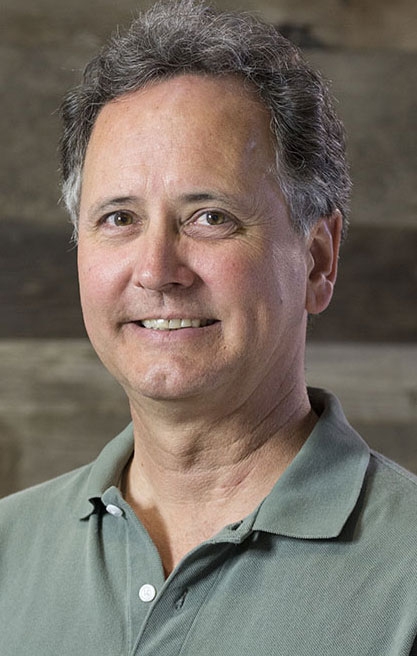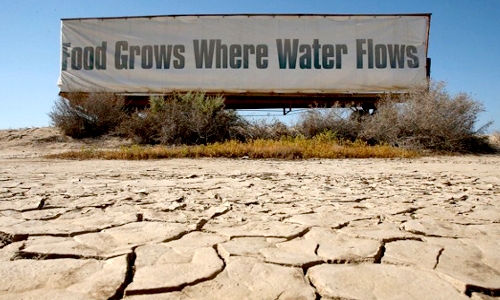Recently, the UC Food Observer caught up with one of California's foremost experts on water: Doug Parker of the University of California. Parker is the director of the University of California's Institute for Water Resources. The mission of the institute is to integrate California's research, extension and education programs to develop research-based solutions to water resource challenges. The institute has recently launched a blog, The Confluence.

Prior to joining UC, Parker worked on water quality issues related to the Chesapeake Bay as an associate professor and extension specialist in the Department of Agricultural and Resource Economics at the University of Maryland. An economist by training, he earned his Ph.D. in agricultural and resource economics at UC Berkeley, and was on faculty there as an extension specialist. He holds bachelor's degrees in economics and environmental studies from UC Santa Barbara.
Q: Governor Brown recently issued an executive order that will restrict urban water usage by 25 percent. How do you see this being enforced across the state? What might enforcement mechanisms look like?
A: The State Water Resources Control Board will set restrictions for each of the over 400 water districts that serve residential consumers in the next month. The 25 percent reduction is meant to be a statewide average for urban users, and the actual reductions will be based on per capita water consumption in 2013. So, areas that are already conserving water will not be asked to reduce as much as the largest water users, who will have to make bigger reductions.
To meet the reductions, individual water districts will each have to draft a plan of how they will bring consumers in their district into compliance. This may include restrictions on outdoor water use and pricing structures that greatly increase costs to large water users and monetary fines. In essence, the reductions are not solely aimed at individual users, but will be made by a combination of reductions by homeowners and industrial and commercial users.
In terms of enforcement, the State Board can fine water districts that are out of compliance up to $10,000 per day. Before fines are enforced, the board will engage the water district to try to help figure out how they can meet the goals.
Q: How much is this going to hurt the average person? What kinds of changes will individuals have to make?
A: The average person will most likely need to reduce outdoor water use, such as landscape watering, and increase conservation measures indoors as well. The easiest way to meet the water reductions is to reduce or eliminate outdoor watering. The governor's order calls for a voluntary, incentive-based program to remove 50 million square feet of turf. Many homeowners may want to consider replacing turf with drought tolerant landscaping. There will also be programs for water efficient appliances like dishwashers and clothes washing machines, and low-flow shower heads. In general, I don't see major changes for the average person, particularly if they've already been conserving and cut outdoor watering, but they will need to take action and be more mindful of their water use.

A: I find it rather disturbing that some people see this as an urban vs. agriculture issue. The California Constitution states that water belongs to the people of the state. It is our water to use for the benefit of all Californians. I myself am happy to be able to cut back on my water use so that it can be used to grow food. What greater use of water do we have? It is inconvenient and perhaps aesthetically unpleasing to have a brown lawn, but compared to food production and food insecurity, the impact on my own life seems pretty minor.
In addition to growing food, the agricultural sector supports jobs in many of our most needy communities. The agricultural water restrictions in 2014 were estimated to have cost the agricultural sector over 17,000 jobs and a loss of over $2 billion. We expect those numbers to increase in 2015.
In the urban sector the drought has had very little impact on jobs or income. In the landscaping industry it remains unclear what impact the drought is having or will have. Reductions in turf irrigation may reduce the need for mowing and other uses of labor. But an increase in turf removal and replacement with drought-tolerant landscaping will lead to an increase in landscaping expenditures and labor.
The thing that I try to keep in mind is that it's all of our water, and we're all in it together.
Q: What happens to California agriculture in the next few years? What might the industry look like 20 years from now? What kind of cropping patterns might we see?
A: I think agriculture will reassess their perception of how secure their water supply is. For those that are seeing large cuts in water allocations, future planting decisions may be more conservative. We may see a decrease in permanent crops to increase flexibility in response to water shortages, though this may be balanced by the fact that things like almonds continue to yield a high value and if you are already reducing crops, keeping the most valuable ones is a rational decision. We will continue to see increases in efficiency, whether through irrigation technology or management of irrigation. We will also see increased investment in surface and groundwater storage to increase resiliency.
Q: Historically, is this drought a bump in the road or a harbinger of things to come?
A: All droughts are a bumps in the road and all droughts eventually end. But, I think we are more used to the speed bump type of drought that slows us to 25 mph. This one is a bit more severe and we probably need to take it down to 5 mph and do some serious long-term planning. Climate models predict that we will see an increase in the frequency and severity of drought. We need to start preparing for this drought to last a few more years and for future droughts as well.
Q: What resources would you recommend people seek out for information on a practical level? What about resources for those who might want to dig deeper?
A: The University of California has many resources to help homeowners, businesses, landscapers and farmers adapt to the drought. Many of those resources can be found on our webpages.
Q: What policies do we need in California to make sure we are able to more effectively respond to these types of crises in the future? What kind of infrastructure would help us more effectively meet our water needs?
A: I think this drought has brought to light the critical importance of groundwater as a resource to lessen the impacts of drought. California passed historic groundwater legislation in 2014 that will ensure this resource is available to us in future droughts. We need to work now to implement this law as quickly as possible. The law's timeline is very generous but I believe that communities that work to accelerate the timeline will greatly benefit from such efforts.
Rose Hayden-Smith is a UC ANR advisor who writes as the UC Food Observer. The UC Food Observer is your daily serving of must-read news from the world of food, curated by the University of California. Visit our blog, and follow us on Facebook and Twitter.
Author - Emeritus - UCCE Advisor in Digital Communications in Food Systems & Extension Education; Editor, UC Food Observer; Food and Society Policy Fellow